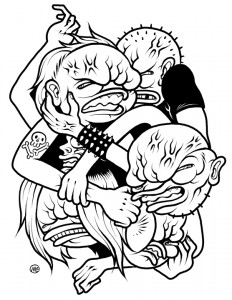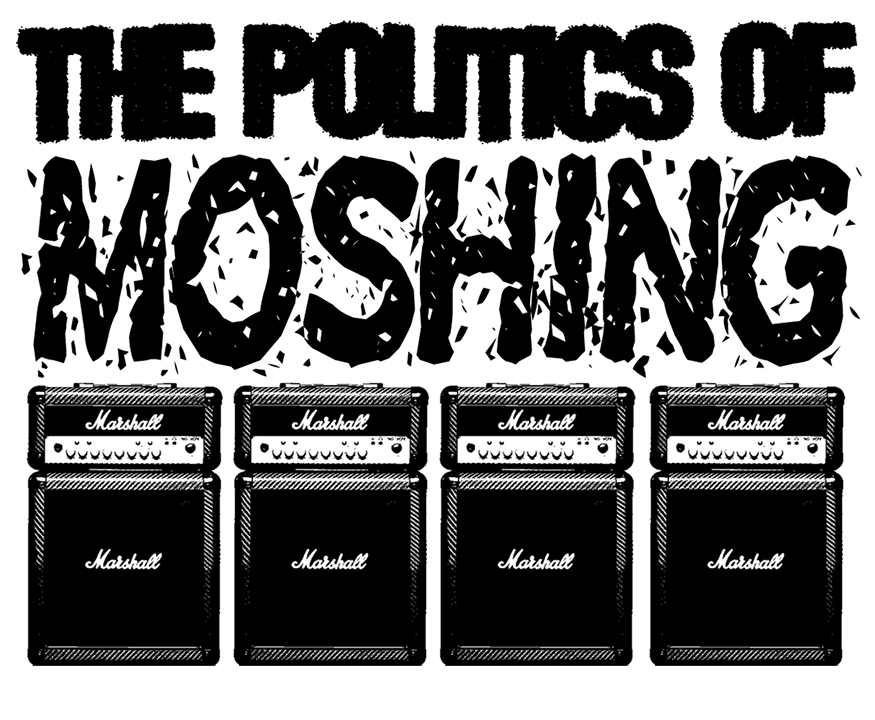The stench of blood, sweat and alcohol seeps from a pulsating mass of limbs. Guttural human cries and the shrieking song of flesh bending nylon wire fills the air. This is a mosh pit. From the outside looking in, a group of young guys slamming their sweaty bodies into each other while yelling is the pinnacle of toxic machismo. But for those inside the pit, this is the cathartic bonding ritual that steals them away from the expectations and pressures of everyday life.
It seems irrational, but moshing serves a purpose in metal and punk subcultures. People use moshing to let go of things they can’t express elsewhere. This especially applies to men who feel stigmatized for showing emotion. Once you look a little deeper, moshing is actually kind of beautiful. Except, if you look even deeper, you realize that it’s a physical manifestation of the sexism and ableism that breeds in the metal and punk scene. “If you don’t want to get hit just move to the back!” cry avid moshers. If you can’t handle the pit then you are both metaphorically and literally pushed out of the scene. If you are not an able bodied, young male, stepping into a pit suddenly makes you realize just how out of place you really are. Your differences, whether it be size, age or disability are highlighted by the unforgiving life force that is the pit. Now the question is, do the political implications of moshing negate the positives? Should we ban moshing at concerts to promote inclusivity? I think ridding the subculture of moshing would be like Funky Winker Beans without Wendy Thirteen – it was kind of the best part. But something still needs to change.
First, let’s dive into the history of the issue. Moshing was a fixture of the L.A. hardcore punk scene from 1967-1980. From there, it was injected into the metal scene by way of crossover thrash bands. The aggression of moshing paralleled the anger and frustration of a generation that wanted to change the world. Punk and metal were born to dissent. Gigs were places of solace for kids who felt left behind by mainstream society. The outpouring of emotion and bodily fluid at punk and metal shows was intoxicating, and bonded people into fiercely loyal subcultures.
However, moshing is not loved by all. Hardcore heavyweights Fugazi have criticized audiences that dance too violently. In 1996, Smashing Pumpkins banned all moshing at their shows after a 17 year old girl was crushed to death. A young woman took a steel-toed boot to the face by way of a spin kicking mosher in a Code Orange pit. She left on a stretcher with her jaw on the opposite side of her face and a brain swollen with blood.

Beside the inevitable injuries, people are speaking out about the ableism and sexism that moshing perpetuates. For instance, people with physical disabilities may require extra space or certain accommodations to mosh themselves, and aggressive pits of destruction are not conducive to these needs. Alternatively, people with less obvious disabilities like mental illness or a developmental disability may feel unsafe in an environment with so much unhinged belligerence flying around. Many women have expressed fear of mosh pits due to being groped, mocked or crushed by their male peers. That is not to say that all women are too frail or weak to mosh. There are plenty of badass ladies that dive into pits and show off the resulting bruises like it’s their first hickey. But, the point being, not all people are physically or mentally prepared for mosh pits. This shouldn’t mean that their experience of the show is less valid. The violent and aggressive mosh pit atmosphere creates an unwelcoming space for those who can’t participate or whose participation is conditional.
These subcultures were built to be transgressive. Yet, moshing creates environments that are unwelcoming to certain marginalized groups, and enforces a norm of what is acceptable and expected. These scenes are now doing exactly what they were built to rail against back in the ‘80s. Perhaps part of the issue comes from the fact that what it means to be transgressive has changed since the time that punk and metal came to fruition. Early punk, in particular, focused on supporting individualism, rebellion and breaking down establishments. Modern society is more aware of social inequalities that just weren’t talked about in the ‘80s. This can include LGBTQ+ rights, women’s equality, racism and ableism. It can’t be denied that many of the issues that punks and metalheads fought for back in the ‘80s still exist today, but maybe it’s time for subcultures to adapt and include contemporary issues in their fight as well.
Do I think this means banning mosh pits? No. But, I think punk and metalheads need to be more aware of the people standing beside them at shows. Everyone is there to express themselves and to feel something bigger than their everyday existence.
To those moshing, don’t take that experience away from someone because you get too rough or aggressive. I urge you to scream your heart out and thrash around. Mosh. But, maintain that ounce of self control that might prevent someone from being pushed away from the scene forever. And for the love of god, don’t wear steel-toed boots into the pit if you’re going to do a spin kick.


